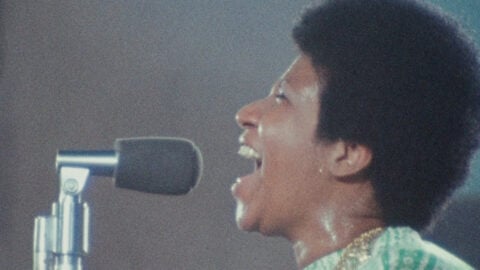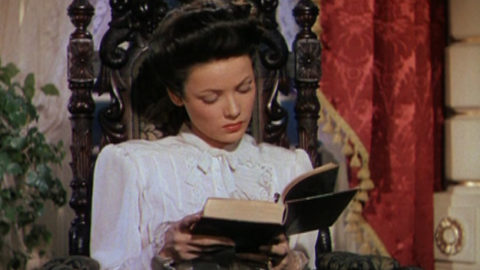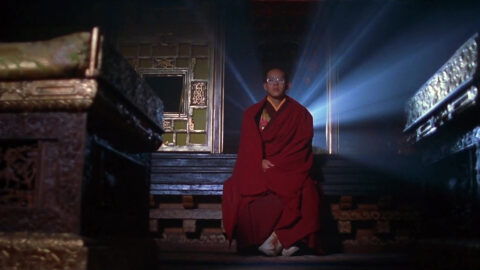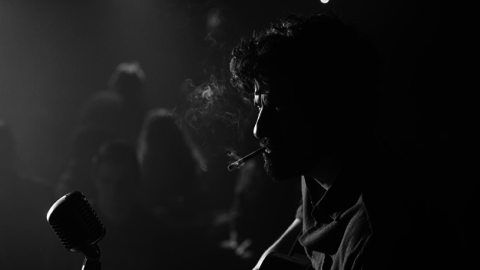Present Tense: Rolling Thunder Revue
Present Tense is a column by Sheila O’Malley that reflects on the intersections of film, literature, art, and culture.
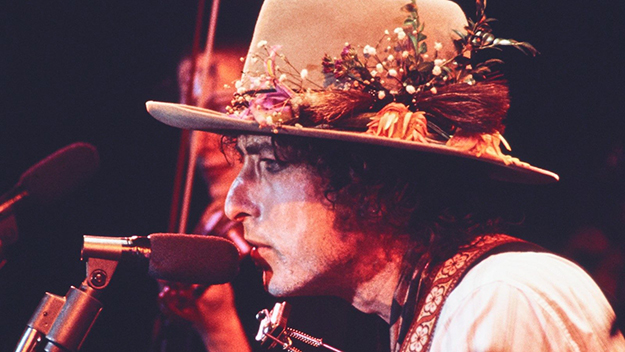 Images from Rolling Thunder Revue: A Bob Dylan Story by Martin Scorsese (Martin Scorsese, 2019)
Images from Rolling Thunder Revue: A Bob Dylan Story by Martin Scorsese (Martin Scorsese, 2019)
Around the time of the release of Highway 61 Revisited in 1965, Bob Dylan suffered through a press conference, where he (seemingly) wriggled out of answering questions. At one point, he’s asked if he considers himself a songwriter or a poet, and he drawls, “I think of myself as a song and dance man, you know.” Everyone bursts out laughing, assuming of course he’s not being serious! There’s no way he means that! It took people a long time to understand Dylan. Some people still don’t understand. His protest songs come from a real place, but so do his persona-shifts and his refusal to be trapped by those who expect him to stay the same.
Martin Scorsese’s Rolling Thunder Revue, a hugely entertaining documentary about Dylan’s 1975–76 “Rolling Thunder” American tour, takes its cue from Dylan himself, a man who started off his career, let’s not forget, by changing his name and telling everyone he was from New Mexico. In other words, don’t believe everything you see and hear. A pound of salt is always required. In his interview for the documentary (his first in a decade), Dylan quotes the famous lines from Walt Whitman’s “Song of Myself”:
Do I contradict myself?
Very well then I contradict myself,
(I am large, I contain multitudes.)
(You can imagine Dylan shouting this at the audiences booing him in 1965-66 when he “betrayed” them by plugging in his guitar.) Rolling Thunder Revue is made up of a collage of concert footage from the tour, as well as latter-day and contemporary interviews with all the main players, including some surprise cameos (“Surprise” being the operative word). Dylan is his classic oblique self, skittish at being pinned down, starting off his interview with: “I’m trying to get to the core of what this Rolling Thunder was about and I don’t have a clue.”
The “revue,” launched in the year before America’s bicentennial, was envisioned by Dylan as a traveling medicine show, a mélange of the Chautauqua circuit, commedia dell’arte, and Elizabethan traveling players. America was in a desolate state economically and emotionally, exhausted from Vietnam and Watergate. Nixon had resigned the year before. Saigon fell in April, 1975. The “revue” moved from town to town (starting in symbolic Plymouth), playing small venues, with little to no advance publicity. It would be a resurrection of the hootenanny coffee-shop-poetry-reading Greenwich Village of the late 1950s and ’60s, the environment which Dylan had taken by storm, and then—famously—left behind. After 1966, he didn’t tour for 8 years, until reuniting with The Band in 1974 for a stadium tour. The Rolling Thunder Revue would be very different.
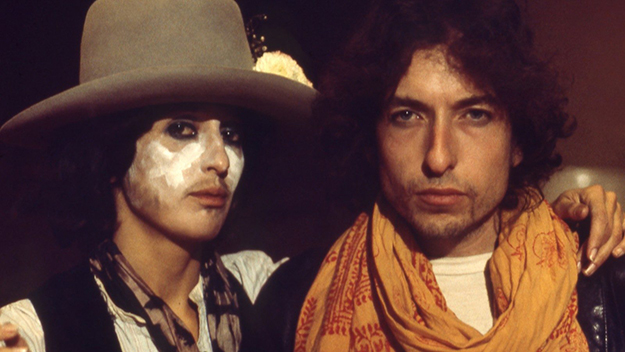
Dylan gathered around him old friends Joan Baez, Allen Ginsberg, Sam Shepard, Ramblin’ Jack Elliott, all of whom would perform in the show. He assembled an extraordinary band, including T Bone Burnett, Rob Stoner, Mick Ronson, Roger McGuinn, and Ronee Blakley. A camera crew tagged along for a film project called Renaldo and Clara, co-written by Dylan and Sam Shepard (it was released in 1978 to a mainly confused response). This footage, shot mostly by David Myers and Howard Alk, was what Scorsese and editor David Tedeschi had to work with. Because the negative was missing and the 16mm print was in terrible condition, the restoration process was painstaking, but the result is stunning. Rolling Thunder Revue has got the unmistakable grit and grain of the ’70s, but there’s no murkiness or cloudiness. If anything, clarity has been enhanced. The film looks very heightened.
Scorsese’s 2005 No Direction Home covered Dylan’s life up through 1966 with a relatively straightforward narrative. Rolling Thunder required a different approach. It opens with a magic trick from one of George Méliès’ films where a magician makes a lady disappear. This should be a clue as how to watch all that follows. There’s footage from Japanese films, from Tony Gatlif’s Latcho Drom, from Marcel Carné’s Les Enfants du Paradis, used to illustrate various points. Along with the old-timey list of “Players” in the end credits (The Oracle of Delphi: Allen Ginsberg, The Ingénue: Ronee Blakley, etc.), Rolling Thunder Revue has a jangly vaudeville aesthetic, in tune with the tour’s loose spirit. Scorsese uses footage from Renaldo and Clara, in particular a “scene” between Baez and Dylan which has to be seen to be believed. Comparing No Direction Home to Rolling Thunder Revue is an object lesson in how content can dictate form.
One of the visions Dylan had for the tour could not be more “song and dance”: everyone would wear masks, or paint their faces white, like Pierrot, or kabuki masters. There’s a rumor started that a certain KISS T-shirt worn by a certain 19-year-old beauty Queen was Dylan’s inspiration for the face paint. Whatever the truth may be (and with Dylan you never know), the effect is startling, distancing and yet electric. Dylan explains in his interview, “When somebody’s wearing a mask, he’s going to tell the truth.” (In this, he echoes Oscar Wilde, who wrote in The Critic as Artist, “Man is least himself when he talks in his own person. Give him a mask and he will tell you the truth.”) With its sleights-of-hand, its presentation of fictional footage, its glee in throwing people off the scent, Rolling Thunder Revue, too, wears a mask.
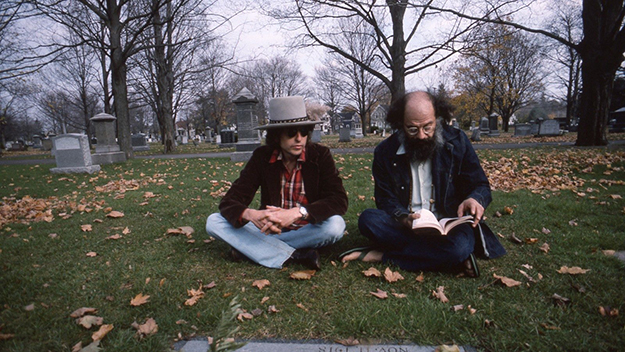
The tour meanders through New England. Joni Mitchell joins the caravan. Scorsese pulls out footage to highlight each player, and everyone has a moment in the sun. There’s Scarlet Rivera, the violinist, who brings a collection of snakes and swords with her on tour. There’s Baez and Dylan, like veterans of a war, tender and wary with one another, their shared history in every glance. Hearing the two of them, so many decades later, praising each other (current-day Dylan admits, “A lot of times when I’m sleeping, I hear her voice”) is poignant. The group visits a retirement home and performs for elderly women hunched over mah-jongg. They play at a Native American reservation, they visit Niagara Falls.
It’s common to say of good concert films that “they make you feel like you are there” but something happens with live performance—something ephemeral and ecstatic—that can’t be easily captured. In A Midsummer Night’s Dream, Quince, one of the traveling “players,” says to his troupe that “the hard thing” about their upcoming performance is a scene that takes place at night: how will they “bring the moonlight into a chamber?” On a metaphoric level, this is the challenge for all artists: to create an illusion so fully an audience gets lost in it too. The astonishing concert footage in Rolling Thunder Revue brings moonlight into the chamber. Crucially, Scorsese allows the performances to play out in full, with no interruptions or premature fade-outs.
The tour kicks off with a ferocious rendition of “Isis,” where Dylan, in black eyeliner, stubble poking through white face paint, decked out in a flowered hat, stalks the crowded stage, like a mad holy man, a shaman, a mime gone off the rails. There’s a maniacal gleam in his eye, and he is, at times, an almost frightening figure. Ralph Waldo Emerson called Walt Whitman a “Minotaur of a man,” and that’s the impression Dylan makes here. He howls that voice of his from the center of a labyrinth. He knows more than we know.
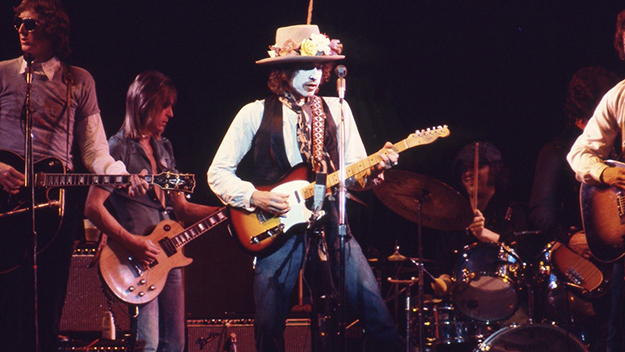
Rolling Thunder Revue includes vital performances of “Tambourine Man,” “Blowin’ in the Wind,” “Hattie Carroll,” a raging version of the already raging “A Hard Rain’s a-Gonna Fall,” an acoustic “Simple Twist of Fate.” His performances of “Hurricane,” a new song protesting the triple murder conviction of boxer Rubin Carter, become central to the tour. When he’s asked by a reporter if this is “Hattie Carroll revisited,” Dylan replies, with remarkable patience, “It’s just that an injustice has occurred.”
In a 2016 interview about Dylan winning the Nobel Prize, Greil Marcus said: “I think the first thing I ever wrote about Bob Dylan was a college paper about Bob Dylan and Walt Whitman. All you really need to know about that topic is not what people said in the ’60s: If Walt Whitman were alive today he’d be playing an electric guitar. No. I think you could say, as Bob Dylan has certainly recognized, that Walt Whitman is his comrade. And Whitman would recognize Dylan as his ‘comerado,’ in his word.” Whitman, whose bicentennial is this year, devoted his life to forging a new kind of poetic language, one wholly “American” (figuring out what that meant was part of Whitman’s quest). Any great poet reflects the world he or she lives in. Whitman did it. Langston Hughes did it. Ginsberg did it. Dylan does it.
There’s an extraordinary moment early on in Rolling Thunder Revue. A young woman stands in a crowded theater. The lights have gone up. The show is over. She is caught up in the experience she just had, and she looks around, a huge smile erupting on her face. But something else rises, a wave of feeling, and she breaks down in tears, covering her face. The pain in the audience—the pain we all have—has been transfigured into something else. In the poem “The Wound-Dresser,” Whitman describes his experiences working in a Civil War hospital, and how he remained “impassive” with the wounded and yet “deep in my breast a fire, a burning flame.” Sam Shepard, reminiscing about the healing effect of the Rolling Thunder tour on audiences, says, “Rock and roll is a kind of medicine.” A “wound-dresser” for a hurting America. Rolling Thunder Revue swims in these sensations, the sadness of reality pierced with the hope of relief, however temporary. I thought of this, from “Song of Myself,” Whitman’s declaration of both individuality and empathy for others:
Undrape! you are not guilty to me, nor stale nor discarded,
I see through the broadcloth and gingham whether or no,
And am around, tenacious, acquisitive, tireless, and cannot be shaken away.
Neither can Dylan.
Sheila O’Malley is a regular film critic for Rogerebert.com and other outlets including The Criterion Collection. Her blog is The Sheila Variations.



